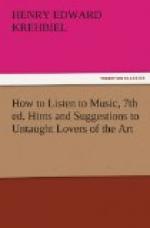[Sidenote: The size of choirs.]
[Sidenote: Large numbers not essential.]
[Sidenote: How “divisions” used to be sung.]
In size mixed choirs ordinarily range from forty voices to five hundred. It were well if it were understood by choristers as well as the public that numbers merely are not a sign of merit in a singing society. So the concert-room be not too large, a choir of sixty well-trained voices is large enough to perform almost everything in choral literature with good effect, and the majority of the best compositions will sound better under such circumstances than in large rooms with large choirs. Especially is this true of the music of the Middle Ages, written for voices without instrumental accompaniment, of which I shall have something to say when the discussion reaches choral programmes. There is music, it is true, like much of Handel’s, the impressiveness of which is greatly enhanced by masses, but it is not extensive enough to justify the sacrifice of correctness and finish in the performance to mere volume. The use of large choirs has had the effect of developing the skilfulness of amateur singers in an astonishing degree, but there is, nevertheless, a point where weightiness of tone becomes an obstacle to finished execution. When Mozart remodelled Handel’s “Messiah” he was careful to indicate that the florid passages ("divisions” they used to be called in England) should be sung by the solo voices alone, but nowadays choirs of five hundred voices attack such choruses as “For unto us a Child is Born,” without the slightest hesitation, even if they sometimes make a mournful mess of the “divisions.”
[Sidenote: The division of choirs.]
[Sidenote: Five-part music.]
[Sidenote: Eight part.]
[Sidenote: Antiphonal music.]
[Sidenote: Bach’s “St. Matthew Passion."]
The normal division of a mixed choir is into four parts or voices—soprano, contralto, tenor, and bass; but composers sometimes write for more parts, and the choir is subdivided to correspond. The custom of writing for five, six, eight, ten, and even more voices was more common in the Middle Ages, the palmy days of the a capella (i.e., for the chapel, unaccompanied) style than it is now, and, as a rule, a division into more than four voices is not needed outside of the societies which cultivate this old music, such as the Musical Art Society in New York, the Bach Choir in London, and the Domchor in Berlin. In music for five parts, one of the upper voices, soprano or tenor, is generally doubled; for six, the ordinary distribution is into two sopranos, two contraltos, tenor, and bass. When eight voices are reached a distinction is made according as there are to be eight real parts (a otto voci reali), or two choruses of the four normal parts each (a otto voci in due cori reali). In the first




